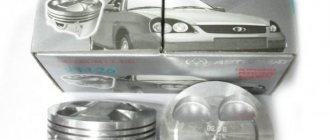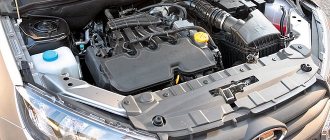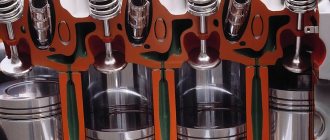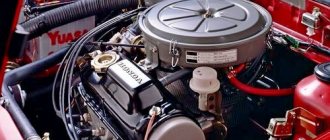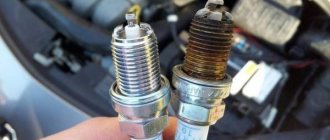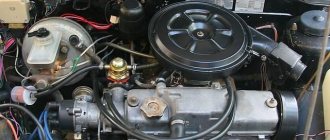02/04/2022 11,036 VAZ Priora
Author: Ivan Baranov
Today, many owners of VAZ Priora cars are faced with such a problem as a broken timing belt, as a result of which the valves “meet” the pistons. As a result, this problem can cost the vehicle owner a pretty penny. To prevent this, some car enthusiasts install STK, STI or Avtramat plug-in pistons on their cars. Read on to find out which pistons are best for your car and how to replace them yourself with photos.
[Hide]
Broken timing belt on Priora
Today we will look at a Priora equipped with a peak design engine 21126 (photo 1), which means that if the timing belt breaks, the pistons collide with valves and other elements, and this, in turn, leads to undesirable consequences. Of course, many drivers are not satisfied with this, and besides, the factory timing life of 200 thousand is practically not achieved in reality. In confirmation of this, there are cases where a belt break occurs during a mileage starting from 30 thousand km, without any apparent reason for this.
Thus, when the timing belt breaks, the owner gets a new opportunity to invest his financial resources in expensive repairs, which include: replacing valves, removing the head and much more. Therefore, Prior owners, whose vehicles are equipped with 16th and 26th engines, are ready to undergo some engine processing in order to obtain plug-inless power devices.
Options for converting Priora engine pistons
This can be done in three ways:
- the first involves replacing the standard ShPG (connecting rod and piston group) of the Priora with a ShPG from the 124th engine (to put it simply, this is a 12 engine with a volume of 1.6 with a tenth connecting rod and a 124 piston). At the same time, it must be taken into account that the power device, at the same time, consumes more fuel, and the bottom, due to the increasing mass, begins to produce more vibration than that of the Priora. In general, it must be said that this method has more disadvantages than advantages. The main advantage is that the motor is plug-free;
- the second option is less budgetary, since it involves replacing the pistons with forgings with large counterbores. A set of such pistons will cost about 6,000 rubles;
- the third option is to replace the piston Priora with an Avtramat (Kharkov). The cost of the kit is approximately 2000 rubles. This, one might say, is a copy of Priora pistons. They are installed on the original connecting rod, have their own piston rings and valve connections. These devices also have a displacer, with which manufacturers have tried to compensate for the decrease in compression levels.
As you know, the current flagship of the domestic automotive industry, represented by the “double-car” AvtoVAZ - Priora, is equipped with a VAZ 21126 engine of 1.6 liters. For those who don’t know, the engine differs from the previous “plug-in” VAZ 21124 in a lightweight connecting rod and piston group, which reduced fuel consumption and noise of the internal combustion engine. Engine power 21126 is officially 98 hp, unofficially, according to our measurements, it is around 100-110 hp.
The previous engine, 21124 with a volume of 1.6 liters, had 2110 connecting rods, 121 mm long, and a heavy piston. Due to the forks, the motor was plug-free.
Priora followed the path of the global automobile industry - a high compression ratio and environmental standards do not want to get along with the “plug-in” design and the engine became plug-in. The pistons 21126 have purely symbolic countersinks and bend when the valve belt breaks. The factory promised a timing drive life of 200 tkm; in practice, the Gates PowerGrip belt broke for some at 40 and 60 thousand km. There are known cases of roller destruction, which also led to bending of valves and subsequent expensive repairs.
Let’s not argue whether the motor should be plug-in or not. The author himself drives a plug-in motor and believes that with proper maintenance and care, there is nothing wrong with such an engine. You need to monitor the condition of the rollers and belt - update the belt in time, and belt breakage is not a problem. For a Priora, it is impossible to tighten the belt (a common cause of timing belt breaks on 8-valve engines is an overtightened belt), due to the fact that the factory installed a semi-automatic roller - when tensioning the belt, you only need to align two slots on the roller.
So, there are a large number of Prioras on the Russian market, some of whose owners do not want to put up with the theoretical possibility of valve bending and they would like to make the engine plug-inless. Let’s not argue with them, but rather consider the possible options for such a rework, as of the end of 2012:
1) Replacing the ShPG with 21124 - install connecting rods 2110 and pistons 21124. A popular option, but the owner will lose all the advantages of the lightweight ShPG. 2) Replacing Priora pistons with pistons from STI - forged pistons have deep forgings and a fairly high price. The pistons are installed with the original connecting rods 21126. 3) The option of replacing the pistons with Ukrainian ones is AVTRAMAT. The pistons are completely similar to the Priorovsky ones, but have a thickened bottom and deep counters. They also have a displacer to compensate for the decrease in the compression ratio due to deep grooves. Moreover, the price of pistons is only 2000 rubles per set.
So, in this report, the author will show an example of a budget conversion of a Priora engine to plug-in pistons. The client's car has low mileage - only about 50 thousand km.
We put the car on a lift, drain the oil and antifreeze, and remove the head. We remove the pan, unscrew the oil receiver (you don’t have to unscrew it, it’s just more convenient to work this way), unscrew the connecting rods and dismantle the ShPG. Out of 4, the car has 3 pistons of group B, one of group C. The cylinders have no wear, the honing grid is like new, but there are slight vertical scuffs.
Since connecting rod 21126 is not centered on the crankshaft, like the tenth connecting rod in the 21124 engine, but is centered on the piston, on the connecting rod bearings we observe running-in marks characteristic only of Priora, with lateral traces of contact on the crankshaft crank pin. There are quite severe scuffs on the piston skirts. For 50 thousand mileage the picture is not very good. In the future, as the skirts wear out, the engine would begin to consume oil. The reasons for such scuffing can be different - lack of lubrication (aggressive driving on a cold, unheated engine), local overheating of the pistons during the break-in mode.
At the beginning of the article, three ways to convert a Priora engine to plugless pistons were listed. Of these, we chose Ukrainian Avtramat pistons. Their price is reasonable (in comparison with forging from STI) - 2000 rubles per set. This kit includes only 4 pistons (pins and their stoppers, as well as piston rings, are not included in the kit). There is a choice of size groups - we took group C. With these pistons, all the advantages of a lightweight connecting rod-piston group are retained, because The Avtramat piston is installed on the original connecting rod 21126 and is as lightweight as the original piston. As you can see in the photo, the piston has thickenings on the bottom in an injection mold, and at the end of the piston we see deep “butt-free” valve counters. Ukrainian designers made the piston skirt wider, although the overall height of the piston corresponds to the original one. Pay attention to the different design of the oil discharge from the oil scraper ring - there are no drillings on the piston, but there are undercuts in the injection mold.
Below are a few photographs of a direct visual comparison of the original Priora pistons and the plugless Ukrainian Avtramat pistons.
We install new pistons on the original Priora connecting rods. Connecting rods, pins, stoppers remain original and do not change. We also do not change the connecting rod bearings. The piston rings were also left by the original ones with a mileage of 50 tkm - they are not worn out or coked. A new cylinder head gasket was installed, the oil and filter were also replaced with new ones.
In general, there is nothing more to say - the block is covered with a head, the timing belt remains factory, the parasitic roller is filled with SMT grease, everything is assembled and the car is started. After starting, there is an hour and a half of running-in at idle speed, and the car is handed over to the client.
Additional nuances and engine operation after replacing the piston can be seen in the video:
Article written: December 30, 2012 Author of the article, photo-video materials: © Quasar Prohibited without the written permission of the author: reprint of the article in whole or in part, reprint and use of photo-video materials, as well as their modification and editing for the purpose of further publication on third parties sites.
Getting to know the ShPG Priora.
Let us now take a closer look at the standard Priora SPG. In our case, it was removed from a car that had traveled a little more than 50 thousand km. The liner is somewhat worn at the edges, which is, however, normal for a Priora, because, as you know, the connecting rod is not centered on the crankshaft, but on the piston, which moves freely in the cylinder. Also in the photo below you can see scuffs on the “skirts”, which also arise from the wear of this car part.
Let us now move on specifically to the replacement process. To do this, we will use the third option proposed. We will replace the standard ShPG Priora with Kharkov Avtramat pistons. To begin with, we note that they have a wider “skirt” than the factory ones, which raises the assumption of an increase in service life and a more tightly fixed piston in the pot, since the factory T-shaped piston, after some time during which it wears out, begins to hang out in the cylinder .
To get acquainted, let’s take a closer look at the videos themselves.
Above is a tension roller, semi-automatic, made in China. Below is a stunning video. If you take into account the mileage of the car, you can see that the condition of the rollers is, to put it mildly, average, since there is a slight leak, and the lubricant has already begun to dry out a little.
Let's take a closer look at the tension roller of the generator belt, which, at the same time, on the Priora serves as a drive belt for the power steering. It is clear that its condition is poor (in practice, this can be understood by the dried grease, as well as the roller itself, which rustles). If necessary, it can be filled with lubricant and it can still serve for some time.
What cars was it in?
Immediately after its release, AvtoVAZ management began using the 21126 engine to power the following Lada models:
- Priora - from 2007 to 2016, all trim levels;
- Kalina - from 2007 to 2013, Luxury equipment;
- Kalina-2 - since 2013, on cars with automatic transmission;
- Granta - since 2011, Norma and Luxury equipment.
Lada Granta
Currently, Priora engines are equipped with 21127 engines, which have become the next version of the development of the 21126 internal combustion engine. On the other two models - Kalina-2 and Granta, this engine is used mainly with the JF414 automatic transmission from the Japanese manufacturer Jatco.
How to replace Priora pistons
Let's move on directly to the process of replacing pistons. In the photo we see that one of the Kharkov pistons has already been installed. Pistons from the Ukrainian company are not sold randomly, as owners would sometimes like, so in this particular case we will take devices from group C. On the second and third cylinders, upon closer inspection, you can see vertical scuffs. In approximately the same places, there are also raised spots on the piston “skirt”, which may be a consequence of racing on a cold engine.
In the photo you can see the factory piston cooling nozzles, which are placed at an angle and hit the rear of the piston. As you can see, the condition of the crankshaft connecting rod journals is quite good for its mileage. We also note that the piston rings remained factory and only one piston and cylinder head gasket (cylinder head) were replaced.
If you are wondering whether the exhaust manifold gasket requires replacement, then the answer is no. It is metal and its service life is long. It is also necessary to note the higher cleanliness of the factory milling of the block and head (compared to the first factory copies), suitable for the metal gasket.
As for this particular head, with a mileage of a little over 50 thousand km, then, as can be seen in the photo, it is in good condition. When the Priora pistons are replaced with Avtramat analogues with deepened counterbores, the plane will need to be cleaned and put in its place.
It should be noted that Avtramat pistons come without pins and without special retaining rings, so only factory components will be installed. As you can see from the photo, there is no wear on the fingers, so there is no need to install new fingers.
Engine tuning
By default, engine 21126 is already boosted by AvtoVAZ designers. However, the power of the internal combustion engine can be further increased by tuning. It is enough to take into account the following nuances:
- The ShPG is already as lightweight as possible, but you can bore the cylinders and use a piston group of a larger diameter;
- tuning of the gas distribution mechanism is most often used - split gear and lightweight Nuzhdin camshaft;
- tuning of the intake and exhaust systems is used - 4 throttles for each cylinder, a “spider” exhaust tract diagram, respectively.
Tuning 21126
To turbocharge the engine, a high modernization budget will be required, the engine life will noticeably decrease and scheduled maintenance will become more frequent.
Thus, ICE 21126 has become an improved version of the previous modification 21124. The power characteristics and service life have increased, the design of the timing drive has been simplified, and the replacement of the belt and rollers has been made easier.
If you have any questions, leave them in the comments below the article. We or our visitors will be happy to answer them
How the connecting rod and piston are placed relative to the crankshaft and block.
There is a special bump placed on the connecting rod, which should look at the timing pulley. That is, the connecting rod and piston are placed in the block in such a way that the timing drive is located on the left, where the hand is located in the photo.
But this is not the only way you can navigate the connecting rod. You should also pay attention to the lock of the earbuds. This lock should be in front and facing you. With this device you can check yourself, because it often happens that the markings on VAZ connecting rods are mixed up. To do this, you need to focus on the locks of the liners, which must be located in front.
As for the piston itself, if you take the “Automatic”, they have a special sign in the form of a piston.
At the top of the piston, the direction is shown by an arrow, but you can also navigate by the notches: the inlet notches are larger in size. Thus, using all these tips, you will put the piston on correctly, according to the marks on the connecting rod.
If you look at the factory pistons, there are no markings on them.
You can only navigate by the arrow drawn on the piston.
She points to the timing drive. You can also additionally navigate by the intake counterbores, which in factory pistons are larger in size than the exhaust ones, as in the Avtramatov ones.
After the block is ready, you will receive a plug-in Priora. Even if the timing belt breaks, the valves will not be damaged. The owner can, if necessary, simply change the belt or roller and continue on his way. In this case, there will be no need to carry out expensive cylinder head repairs.
The presented replacement option has several advantages:
- relative efficiency;
- the possibility of preserving the original Priora long connecting rod, which will provide high engine power as well as high torque.
- Low fuel consumption will be maintained.
This is what an assembled engine looks like with Avtramat pistons with enlarged valve counterbores, filled with oil and antifreeze. Please note that the engine must undergo the so-called initial run-in at idle speed (approximately 1 hour). After this, the car can be used as usual.
Disadvantages and advantages
The indicated characteristics of the engine and real experience in its operation since 2007 allow us to judge the shortcomings:
- a broken timing belt is fraught with major repairs;
- due to the need for high-quality lubrication, the vehicle operating budget increases;
- The cost of overhaul is affected by the high price of the timing belt and rollers, ShPG of foreign manufacturers, even if it is made by hand.
On the other hand, the motor has much more advantages; they outweigh the indicated disadvantages:
- lack of constant valve clearance adjustments;
- increase in service life, power and torque;
- reduction of noise and vibrations;
- economical fuel and oil consumption;
- compliance with Euro-4 standard.
Metal gaskets last longer, and the timing belt does not need to be constantly tightened and monitored for accidental slippage when oil gets in.
